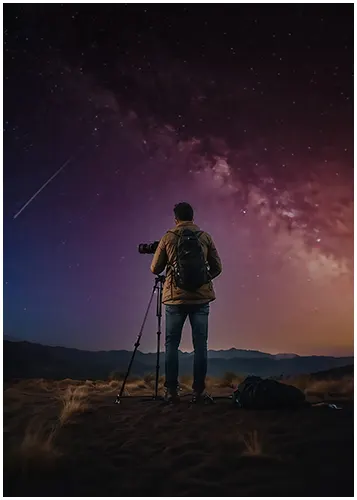
Harness the Power of Light and Shadow in Landscape Photography
In photography, light and shadow are essential for creating captivating photos. It’s important to grasp


So, you’re intrigued by the beauty of the stars and want to capture stunning images with your camera and lens? Welcome to the fascinating realm of Night Sky Photography!
Night Sky Photography involves pointing your camera to the sky to capture amazing images of celestial bodies. For example, snapping vibrant shots of the Milky Way on a clear night. You don’t need a spaceship to start, guess what? Just your camera, modifying a few settings, and some helpful accessories.
The sky is indeed the limit, let’s explore!
Camera gear is crucial for night sky photography as it determines the image quality and your flexibility in capturing celestial bodies. Here are some essential features:
Pros:
Cons:
Note: Prices vary across different features and brands. Choose what suits your needs and budget.
Gone are the days when one could claim outright superiority for either mirrorless or DSLR cameras. The latest advancements have blurred the lines, making the choice more about personal preferences and specific shooting styles. Picture yourself under a canopy of stars, pondering which camera is your guiding star in the realm of night sky photography. Not going to happen!
Both mirrorless and DSLR cameras have their unique strengths and quirks, much like the stars in our night sky. It’s your skill, your dedication, and your eye for detail that will ultimately determine your success in capturing the ethereal beauty of the cosmos. The best advice I can give you is to get out there and shoot.
With a fast wide angle lens, capturing the majesty of the night sky becomes a thrilling reality. It’s your ticket to detail-rich night landscapes, capable of gathering enough light for vibrant, sharp shots.
Remember, in night sky photography, your lens is the wide-open eye to the cosmos.
In night sky photography, the importance of a sturdy tripod cannot be overstated. It’s not just an accessory, but an essential piece of gear. Here’s why:
Remember, quality is key – a good tripod can make the difference between a blurred mess and a breathtaking representation of the night sky.
A Remote Shutter Release is a handy gadget that significantly elevates your night sky photography skills. It lets you snap photos without touching your camera, thereby offering crisp, blur-free shots. Here’s why it’s a game-changer:
Nighttime photography, especially of the breathtaking sky, is an exhilarating experience. But, without keeping track of your batteries, you could end up with disappointing results. Remember, batteries are as crucial as your camera. Let’s look at why:
Bear in mind, any interruption during the shoot could ruin your entire effort, so always be over-prepared in terms of power sourcing.
A night filter is a game-changer for night sky photography. It helps filter out wavelengths of light pollution, thus improving the clarity and balance of your shots.
Although not exactly budget-friendly, it’s worth every penny for the level of precision it allows.
A Focus Aid Filter, also known as a Bahtinov mask, helps with precise focus in night sky photography and astrophotography.It consists of a mask with a specific pattern of slits or lines arranged in a specific way.
Here’s how it works:
This tool is particularly useful for astro-photographers because achieving accurate focus in the dark night sky can be challenging. The Focus Aid Filter simplifies the process and helps produce sharper and more detailed images of celestial objects.
Mastering the art of focusing your camera in the dark is an absolute game-changer. Picture yourself in the pitch-black wilderness, with the Milky Way sprawled across the heavens – that’s your canvas. Here are some pro-tips to ensure your focus is as sharp as the stars themselves:
Pros:
Cons:
With a bit of practice, you’ll sharpen your focusing skills and elevate your night sky photography to new heights. Happy stargazing!
A headlamp will be your trusty sidekick. Why? It ensures you can set up, focus, and adjust your camera with both hands free in the dark, making it a vital piece of kit. Just remember to flick it off before hitting the shutter. Also, look out for these top-notch features:
A tracking app for night sky photography can be a game-changer. Why? It’s like having an astronomical guide right in your pocket. Top features include:
As for pros and cons:
With this tool, you’re not just shooting in the dark!
Your smartphone isn’t just a communication tool, it’s a critical companion for your night sky photography ventures. It helps you navigate to remote locations, serves as a lifeline in emergencies, and, with the right apps, acts as an all-in-one photography assistant. Here are its notable features:
In closing, remember your star photography journey relies heavily on the right gear. Equip yourself with a large aperture lens for shooting vibrantly detailed starry skies. Incorporate a star tracker to enhance the clarity and impact of your Milky Way snaps. Always count on long exposure to capture stunning astrophotography images. Then, remember to ‘stack’ images for a mesmerizing night sky view. Don’t forget to meticulously plan each shot—and hey, feel free to experiment along the way. Embarking on this captivating night sky photography journey, we wish you clear skies and memorable captures!
For night photography, essential equipment includes a full-frame camera, wide angle lens, tripod, a quality headlamp, and light pollution filter. Remember to pack spare batteries.
The distance you need to wander out of town to find acceptably dark skies for star photography varies. You can use resources like light pollution map info to find places with less light pollution and ideal for capturing clear star images.
To capture clear photos of the night sky, you’ll need a stable tripod and a wide-angle lens with a large aperture. Keep the ISO setting low to minimize noise. Additionally, capturing in a dark, remote location away from light pollution and using manual focus for precision are key techniques.

In photography, light and shadow are essential for creating captivating photos. It’s important to grasp

Looking to kill off an hour while in Nanaimo, BC? Just a short hop-skip and

Photography can be a fulfilling and enjoyable hobby that brings a creative outlet to your